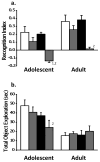Effects of ethanol, Δ(9)-tetrahydrocannabinol, or their combination on object recognition memory and object preference in adolescent and adult male rats
- PMID: 22959891
- PMCID: PMC3477605
- DOI: 10.1016/j.neulet.2012.08.037
Effects of ethanol, Δ(9)-tetrahydrocannabinol, or their combination on object recognition memory and object preference in adolescent and adult male rats
Abstract
Recent advances have been made in our understanding of the deleterious effects of both ethanol and THC on adolescent behavior and brain development. However, very little is known about the combined effects of EtOH+THC during adolescence, a time in which these drugs are often used together. The purpose of this experiment was to: (1) determine whether EtOH and/or THC induced greater working memory impairment in adolescent than adult male rats using the novel object recognition (NOR) task and (2) determine whether the EtOH+THC combination would produce a more potent additive effect in adolescents than adults when compared to these drugs alone. NOR was performed with a 24h delay under each of the four drug conditions: vehicle; 1.5g/kg ethanol; 1.0mg/kg THC; and 1.5g/kg EtOH+1.0mg/kg THC, at 72h intervals. The results show that there was an age effect on working memory in NOR after the EtOH+THC challenge. Specifically, adolescent animals showed a preference for the familiar object whereas adults showed no preference for the novel or familiar object, the latter being characteristic of a classic working memory deficit. These effects were not dependent on changes in exploration across session, global activity across drug condition, or total object exploration. These novel findings clearly indicate that further understanding of this age-drug interaction is crucial to elucidating the influence that adolescent EtOH+THC use may have on repeated drug use and abuse later in life.
Published by Elsevier Ireland Ltd.
Figures

 Ethanol; ■ THC;
Ethanol; ■ THC;
 Ethanol + THC) on novel object recognition performance were significant, p = 0.006, and p ≤ 0.001, respectively. (Panel a) Recognition index: (Novel − Familiar)/(Novel + Familiar) +/− SEM. (Panel b) Total object inspection time: (Novel + Familiar) +/− SEM. 1 p<0.05 compared to zero; 2 p<0.05 compared to vehicle.
Ethanol + THC) on novel object recognition performance were significant, p = 0.006, and p ≤ 0.001, respectively. (Panel a) Recognition index: (Novel − Familiar)/(Novel + Familiar) +/− SEM. (Panel b) Total object inspection time: (Novel + Familiar) +/− SEM. 1 p<0.05 compared to zero; 2 p<0.05 compared to vehicle.Similar articles
-
Deleterious Effects of Ethanol, Δ(9)-Tetrahydrocannabinol (THC), and Their Combination on the Spatial Memory and Cognitive Flexibility in Adolescent and Adult Male Rats in the Barnes Maze Task.Pharmaceutics. 2020 Jul 9;12(7):654. doi: 10.3390/pharmaceutics12070654. Pharmaceutics. 2020. PMID: 32660138 Free PMC article.
-
Memory impairment following combined exposure to delta(9)-tetrahydrocannabinol and ethanol in rats.Eur J Pharmacol. 2002 Aug 9;449(3):245-52. doi: 10.1016/s0014-2999(02)01999-4. Eur J Pharmacol. 2002. PMID: 12167466
-
Role of cannabinoid receptor type 1 desensitization in greater tetrahydrocannabinol impairment of memory in adolescent rats.J Pharmacol Exp Ther. 2010 Nov;335(2):294-301. doi: 10.1124/jpet.110.169359. Epub 2010 Jul 28. J Pharmacol Exp Ther. 2010. PMID: 20668056 Free PMC article.
-
Vaporized Δ9-tetrahydrocannabinol exposure in utero has negative effects on attention in a dose- and sex-dependent manner.Pharmacol Biochem Behav. 2024 Sep;242:173808. doi: 10.1016/j.pbb.2024.173808. Epub 2024 Jun 22. Pharmacol Biochem Behav. 2024. PMID: 38914267
-
Prenatal alcohol and tetrahydrocannabinol exposure: Effects on spatial and working memory.Front Neurosci. 2023 Jun 13;17:1192786. doi: 10.3389/fnins.2023.1192786. eCollection 2023. Front Neurosci. 2023. PMID: 37383100 Free PMC article.
Cited by
-
Can prenatal methamphetamine exposure be considered a good animal model for ADHD?Physiol Res. 2021 Dec 31;70(S3):S431-S440. doi: 10.33549/physiolres.934815. Physiol Res. 2021. PMID: 35099261 Free PMC article.
-
Combined ∆9-tetrahydrocannabinol and moderate alcohol administration: effects on ingestive behaviors in adolescent male rats.Psychopharmacology (Berl). 2019 Feb;236(2):671-684. doi: 10.1007/s00213-018-5093-3. Epub 2018 Nov 10. Psychopharmacology (Berl). 2019. PMID: 30415276 Free PMC article.
-
Persistent effects of chronic Δ9-THC exposure on motor impulsivity in rats.Psychopharmacology (Berl). 2015 Aug;232(16):3033-43. doi: 10.1007/s00213-015-3942-x. Epub 2015 Apr 30. Psychopharmacology (Berl). 2015. PMID: 25925779
-
Deleterious Effects of Ethanol, Δ(9)-Tetrahydrocannabinol (THC), and Their Combination on the Spatial Memory and Cognitive Flexibility in Adolescent and Adult Male Rats in the Barnes Maze Task.Pharmaceutics. 2020 Jul 9;12(7):654. doi: 10.3390/pharmaceutics12070654. Pharmaceutics. 2020. PMID: 32660138 Free PMC article.
-
Cortical thickness and neurocognition in adolescent marijuana and alcohol users following 28 days of monitored abstinence.J Stud Alcohol Drugs. 2014 Sep;75(5):729-43. doi: 10.15288/jsad.2014.75.729. J Stud Alcohol Drugs. 2014. PMID: 25208190 Free PMC article.
References
-
- Monti PM, et al. Adolescence: booze, brains, and behavior. Alcohol Clin Exp Res. 2005;29(2):207–20. - PubMed
-
- White AM, Swartzwelder HS. Age-related effects of alcohol on memory and memory-related brain function in adolescents and adults. Recent Dev Alcohol. 2005;17:161–76. - PubMed
-
- Cha YM, et al. Sex differences in the effects of delta9-tetrahydrocannabinol on spatial learning in adolescent and adult rats. Behav Pharmacol. 2007;18(5–6):563–9. - PubMed
-
- Cha YM, et al. Differential effects of delta9-THC on learning in adolescent and adult rats. Pharmacol Biochem Behav. 2006;83(3):448–55. - PubMed
Publication types
MeSH terms
Substances
Grants and funding
LinkOut - more resources
Full Text Sources
Medical

